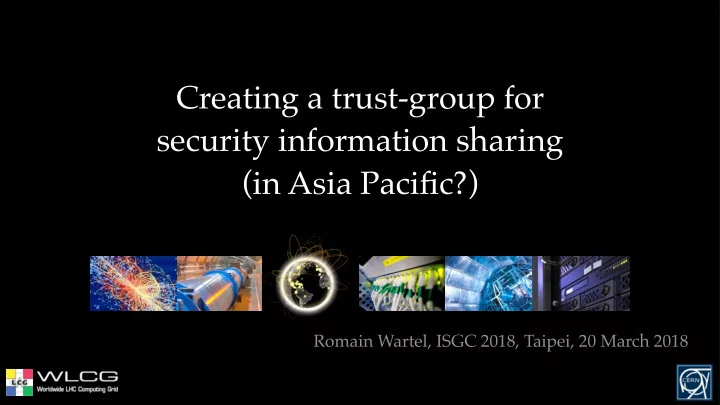

Creating a trust-group for security information sharing (in Asia Pacific?) Romain Wartel, ISGC 2018, Taipei, 20 March 2018
Indicators of compromise • Examples of indicators: – IP or domain names • May be shared and used for legitimate purposes or recycled • Easy to use – File names or file hashes • May be trivially changed • Easy to use – Yara rules, regular expression, etc. • Less chance of false positives • More costly to use – Email headers and fields 2
Threat intelligence • Proposed definition — not universal • Threat intelligence includes: – Indicators of compromise (IP addresses, hashes, etc.) – Contextual information – Tactics, Technique and Procedures for a malicious actor • Goal: Enable the recipient to take action – As a preventive measure – As a remediation against ongoing or past attacks 3
Sourcing intelligence • No shortage of sources! • Public feeds, raw or filtered • Paid-for feeds from security vendors • Tailored blends of private and public feeds for sale • “Black box” appliances – Intelligence data not available for review – Data is analysed by the system or appliance – Alert is raised upon positive match of a proprietary indicator • But is this a good investment? – Catch more than low-risk threats and internet background noise? – How about the false positive rate? 4
Relevance • Actors are continuously changing parameters – Change at least partially their infrastructure for each campaign – Fast-flux DNS infrastructures – Domain Name Generators for Command & Control – Randomised email content, mail headers (from field, subject. etc.) – Randomised malware payload (different filename and hash) • Relevance – Is it relevant to my sector, local configuration and location? – Is it actionable? – Reasonable to expect a low or manageable false positive rate? 5
Quality • Key aspects of threat intelligence quality – Malicious • Often malware contacts “8.8.8.8” • Behavior requires careful analysis before flagging as indicator – Targeted • Full URLs are better than domains or IPs • Multiple customer may use the same domain • sharepoint.com or https://supremeselfstorage-my.sharepoint.com/personal/andrew_supremeselfstorage_com_au/_layouts/15/guestaccess.aspx? guestaccesstoken=GTQPc%2brKLAsKHba4nXtvl0hXrBsUmCUxoYGuu9msk0U%3d&docid=0c4b96dfd3319496a8feb1a56d88de679&rev=1 – Timeliness • Bad actors also read the news and at least public feeds • Domains and IP addresses get re-assigned quickly (especially IPv4) • Infected hosts are being cleaned • Who can provide quality and relevant threat intelligence? 6
Back to the basics • Research & Education is a viable market for cybercriminals – Ransomware, finance fraud, etc. • Offers a favorable cost/benefit ratio for many bad actors • Main attackers profile: – Cybercriminals (money) — less opportunistic, more targeted – Hacktivists (delay, disrupt, destroy) – Nation-states (data, strategy, tender info, technology, IP) 7
Back to the basics • Most serious attack will be complex or sophisticated – Can your organisation or project defend against a nation-state or an international criminal gang with a multi-million dollars budget for both its malware and distributed attacking computing infrastructure ? – As individual organisations, it is not affordable – But as a community, we are much better positioned! • Sharing information, expertise… and threat intelligence is key 8
Trust and threat intelligence • Threat intelligence in not necessarily a service • Threat intelligence is an expression of a trust relationship • Response to threats as a community – Best mean to fight sophisticated adversaries at acceptable costs 9
Building a cohesive community 1. Identify like-minded organisations 2. Identify security or technical experts within them, or anyone willing to collaborate 3. Build trust relationships between participants (physical meeting, sharing war stories, etc.) 4. Establish common goals, needs and issues 5. Enable participants to share sensitive information (tools, mailing list) 6. Enable participants to act on intelligence… and share back! 7. Add value by pooling resources/effort (extra expertise for forensics, tools, etc.) 8. Establish strong external links with the of the security community (cross-membership, etc.) 10
How to encourage new members to join? • The community can provide: – Free expertise, help, tools, tutorials, etc. – Indicators of compromise, experience from attacks • New members can provide with no security expertise: – Contact points – Access to compromised machines – Data, log files • As a new member, the bar is very low. But the benefits are high! • Similar strategy when small trust groups aim at participating in global groups – Be pro-active, share what you have/can, build trust relationship, profit. 11
Conclusion • Best way to defend is to do it as a community • Threat intelligence is an output of a community response • Essential to support communities in: – Building trust – Creating and sharing value – Provide support on technical issues – Connect to other Internet security trust groups • How can we (WLCG) help? • Maybe a new operational security trust group could emerge from: – Asia Tier Forum? APGRIDPMA? APAN Security Working Group? PRAGMA? 12
Confidentiality Don’t Share Share only with your team Share with community but not public Share with anyone 13
Mattermost or Slack 14
MISP 15 https://www.circl.lu/services/misp-training-materials/
MISP 16 https://www.circl.lu/services/misp-training-materials/
MISP 17 https://www.circl.lu/services/misp-training-materials/
Acting on threat intelligence • Sadly, sharing great threat intelligence is not sufficient • Acting on indicators is a significant challenge! • Each participant must: 1. Collect enough information locally • Network flows, local logs, emails headers, etc. 2. Accumulate, parse and incorporate incoming threat intelligence 3. Correlate local information and indicators 4. Take appropriate action & manage false positives • Not only a technical challenge – Security teams “already busy” with other things – Not all data (step 1) may be within (legal, technical) reach – Need cooperation between different teams 18
Recommend
More recommend